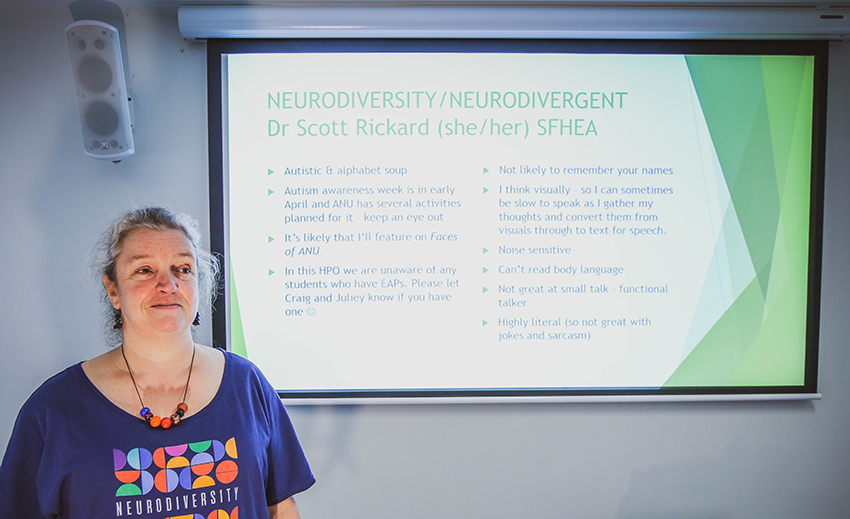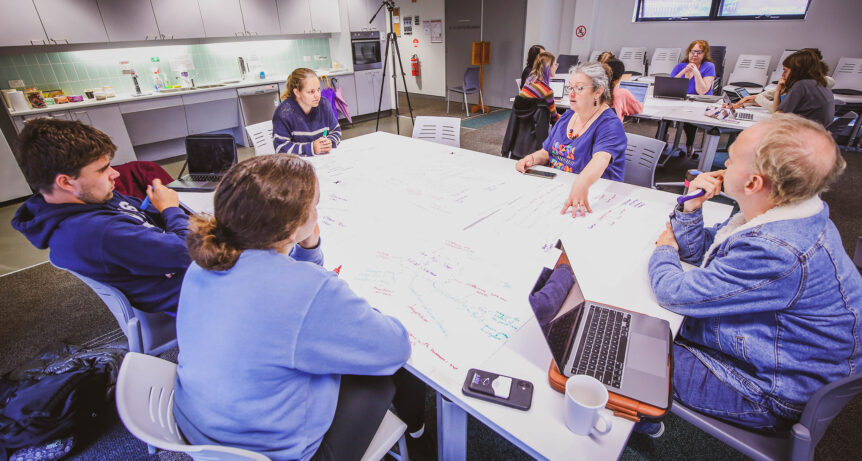Have you ever wondered how you can better assist your autistic student cohort? To mark Autism Awareness Day 2021 on 2 April, ANU Educational Designer Dr Scott Rickard has shared some tips to help you better understand this cohort and their needs in the classroom.
A good starting point for designing for any disability is Universal Design for Learning (UDL). However, designing specifically for autistic and neurodivergent students is likely to need a variety of different approaches as autistic people communicate differently (social interaction) and are likely to react differently to things that affect our senses (built environment).
A significant number of autistic people, including myself, have co-occurring neurological conditions, such as ADHD, OCD and dyslexia, along with medical conditions. This can sometimes make it tricky to know how your autistic students might respond in your class. It’s also tricky because the diversity is likely to be in opposition at times. For example, you are just as likely to have students in your class who don’t mind noise but can’t stand smells, and student who can’t stand noise but can withstand some smells. So it’s best to just ask them what they’d prefer and open a conversation around it at the beginning of the semester.
One way to discover all the nuances in your class is to create an icebreaker which celebrates diversity and different ‘voices’, and provides a safe environment for students to share. The icebreaker can be done using Padlet, butchers paper or even using a polling tool. If you’re neurodivergent yourself, you may want to share some of your points of difference as I did recently.
My key tips for designing for neurodivergent students would be:
Interacting with other students
- Autistic students can find it challenging to navigate social interaction and collaborative learning because:
- We can be very literal and are less likely to be able to understand inference, sarcasm and jokes, so it’s easy to misunderstand things.
- There is a tendency towards functional speech rather than chatting and socialising.
One solution is to set some rules around how your groups will socially interact from the outset, implementing inclusive principles, and to encourage the use of plain English.
- Learning experiences which involve close proximity can be problematic for sensory issues such as noise, touch or smell.
- A student may request that they can’t take part in the activity, e.g. a biology student at a live dissection, so have another option ready that still enables them to take part.
- The need to stim or their response to sensory issues may be off-putting to other students so an open discussion at the beginning of semester helps to ease this tension.
Designing your curriculum and weekly tutorials, workshops or lab sessions
- Provide multiple options for accessing content and engaging in learning experiences.
- The diversity within autistic cohorts means that students are likely to need to use multiple ways to access content. A student with both autism and ADHD is a good example of this: They are less likely to be able to hold, recall and manipulate critical periods of information. Providing only one method, such as a lecture delivered orally, makes it difficult and stressful for neurodivergent students. A transcript helps them to fill in the gaps.
- Some neurodivergent students may have auditory or learning disorders (like me). Ensure that, if you are asking students to perform a task, that it is written down as well as spoken to enable the student to understand what is required.
- Design assessments that intrinsically motivate neurodivergent students.
- Provide criteria around the topic choice so that students understand why one topic is more suitable than another.
- Ensure that the criteria have a boundary effect. Autistic students are likely to ‘see’ 100 options for something where many other students will only see 10. Creating and using boundaries and criteria is helpful.
- Provide students with regular short breaks in their weekly run sheet. This provides students with opportunities to ’escape’ the classroom, address sensory issues or stim, if required.
- Provide students with run sheets which outline what will happen each week in the classroom and include URLs to activity types for explanation. This helps students to adjust to and prepare for what will be required.
If you need any help with designing for a neurodivergent cohort, please contact us at eddesign@anu.edu.au.

April 2021
Dr Scott Rickard is autistic, an Educational Designer at the Centre for Learning and Teaching and
the Chair of the ANU Disability Action Plan Education Provider of Choice Action Group.

